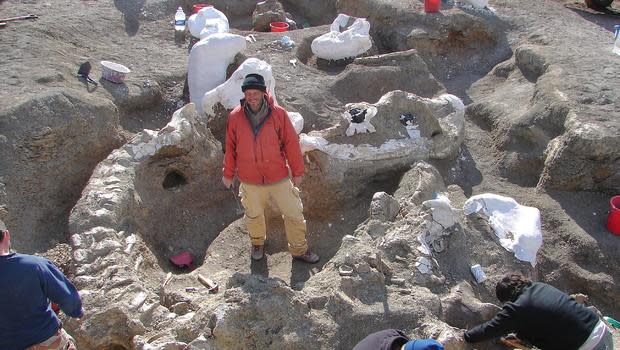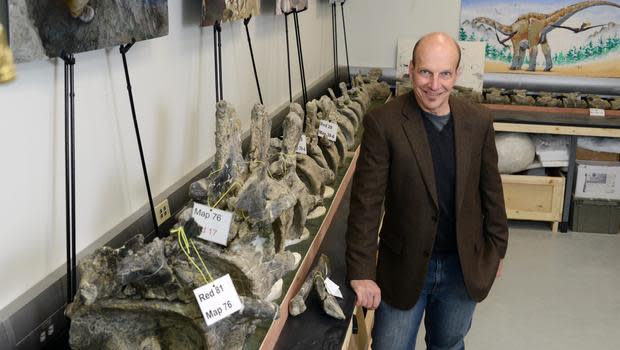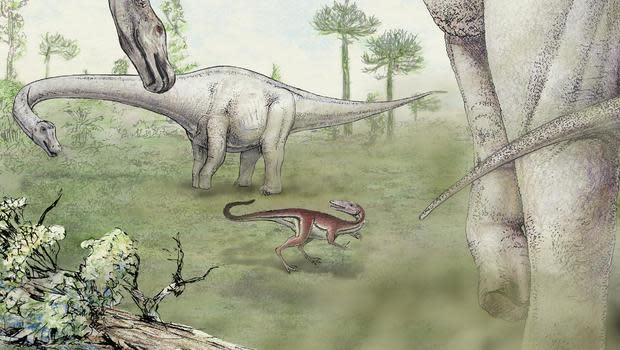"Astoundingly huge" dinosaur skeleton unearthed
Scientists have unearthed the skeleton of a previously unknown, massive dinosaur species that may be the largest land animal ever found.
The specimen named Dreadnoughtus schrani is exceptionally complete, with about 70 percent of its bones recovered. Scientists believe the creature, which lived about 77 million years ago, measured 85 feet (26 meters) long and weighed about 65 tons, heavier than a Boeing 737.
Previously discovered "super-massive" dinosaurs are known only from fragmentary fossils, and therefore the new skeleton provides researchers with a unique opportunity to learn about the anatomy and evolutionary history of one of the largest animals that ever lived.
The researchers excavated the fossil in southern Patagonia, Argentina, over four field seasons between 2005 and 2009. A smaller specimen of the same species with a less-complete skeleton was also discovered at the site.
"Dreadnoughtus schrani was astoundingly huge," said study author Kenneth Lacovara, an associate professor at Drexel University in Philadelphia, who discovered the Dreadnoughtus fossil skeleton and led the excavation and analysis. "It weighed as much as a dozen African elephants or more than seven T. rex."
Moreover, the researchers believe that when this 65-ton animal died, it was not even done growing.
"It is by far the best example we have of any of the most giant creatures to ever walk the planet," Lacovara said.

Kenneth Lacovara of Drexel University, surrounded by the skeleton of Dreadnoughtus schrani Kenneth Lacovara
Researchers have identified about 100 pieces of the gigantic skeleton, including most of the vertebrae from the animal's 30-foot-long tail, a neck vertebra with a diameter of over a yard, toes, a claw and even a single tooth.
The plant-eating dinosaur, with characteristic peg-like teeth, plank-like ribs and huge legs, belongs to a group called titanosaurs that were common in southern continents around 66 to 100 million years ago.
"Titanosaurs are a remarkable group of dinosaurs, with species ranging from the weight of a cow to the weight of a sperm whale or more," Matthew Lamanna of the Carnegie Museum of Natural History, one of the researchers who unearthed the skeleton, said in a statement. "But the biggest titanosaurs have remained a mystery, because, in almost all cases, their fossils are very incomplete."

Kenneth Lacovara, PhD, with the 30-foot tail of Dreadnoughtus schrani, stretching along the length of the wall and around the corner. Drexel University
The researchers also prepared 3D laser scans of most of the fossil bones from the specimen to better visualize the skeletal structure of the animal.
"This has the advantage that it doesn't take physical space," Lacovara said. "These images can be ported around the world to other scientists and museums."
Inspired by the creature's invincible appearance, scientists named the specimen "Dreadnoughtus," which means "fears nothing."
"With a body the size of a house, the weight of a herd of elephants, and a weaponized tail, Dreadnoughtus would have feared nothing," Lacovara said. "That evokes to me a class of turn-of-the-last century battleships called the dreadnoughts, which were huge, thickly clad and virtually impervious."

The reconstructed skeleton and body silhouette of Dreadnoughtus, showing fossil bones that were found in white. Lacovara et al.
The latter part of the name, "schrani," was chosen in honor of American entrepreneur Adam Schran, who provided support for the research.
Considering the animal's huge size, the researchers estimated that the dinosaur must have fed constantly on massive quantities of plants.
"Imagine a life-long obsession with eating," Lacovara said.
The study describing the discovery was published Thursday in the journal Scientific Reports.

Artist's rendering of two Dreadnoughtus schrani, shown here menacing a much smaller meat-eating dinosaur. Illustration: Mark A. Klingler, Carnegie Museum of Natural History

